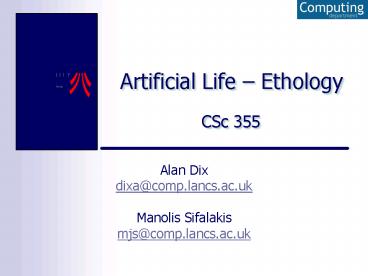Artificial Life - PowerPoint PPT Presentation
Title:
Artificial Life
Description:
Artificial Life Ethology CSc 355 Alan Dix dixa_at_comp.lancs.ac.uk Manolis Sifalakis mjs_at_comp.lancs.ac.uk Lecture Overview What is Alife Brief history timeline ... – PowerPoint PPT presentation
Number of Views:112
Avg rating:3.0/5.0
Title: Artificial Life
1
Artificial Life Ethology
CSc 355
- Alan Dix
- dixa_at_comp.lancs.ac.uk
- Manolis Sifalakis
- mjs_at_comp.lancs.ac.uk
2
Lecture Overview
- What is Alife
- Brief history timeline
- Synthetic Ethology and Food Chains
- Example Food Chain model
- Agent Anatomy
- (Pseudo-) code
- Sample iteration
- Results
- Observations
- Reference List
3
What is Alife ?
- Alife Langton is set of mechanisms used to
model and simulate evolving natural systems - Insect ecologies, animal behavior, negotiating
entities, resource use in artificial economies - Studies the evolution of agents, or populations
of computer simulated life forms in artificial
environments - Complements traditional biology by trying to
recreate biological phenomena
4
What is Alife ?
- Traditionally AI a top down approach
- Alife works from the bottom up
5
Brief history - Timeline
6
Synthetic Ethology Food Chains
- Synthetic Ethology
- Study of animal behavior in which simple,
synthetic organisms are allowed to behave and
evolve in a synthetic world. - Branch of zoology
- Food Chain
- Describes the hierarchy of living organisms
within an ecosystem.
7
Example Food Chain Model (FCm)
- 3 Entities
- Plants
- Fixed location, consumed by herbivores
- Herbivores
- Migratory agents, eat plants, eaten by carnivores
- Carnivores
- Migratory agents, eat herbivores, die from
starvation - Environment
- Toroid grid
- Each cell occupied by one or more agents
8
FCm Agent Anatomy
The Agent
Agent brain
Agent perception of the environment
9
FCm Agent Life Death issues
- Energy (E) / Metabolism
- Eat ? E E 1
- For each step ? E E X, (H X1, C X2)
- If E 0 ? Die
- Reproduction
- If E gt 90 ? Reproduce asexually
- Lamarckian Offspring inherits parents NNet
followed by random mutation of weights - Death
- Starvation (no food found)
- Eaten (only for herbivores
10
FCm The (pseudo-) code
- Main ( )
- Init ( )
- while (run lt MAX_RUNS)
- SimulateOnce ( )
- Init ( )
- landscape InitLandscape ( )
- GrowPlants ( landscape plants )
- while ( agents lt MAX_AGENTS )
- agent CreateAgent ( )
- if ( agent.type herbivore )
- PositionAgent ( landscape
herbivores ) - else
- PositionAgent ( landscape
carnivores )
11
FCm The (pseudo-) code
SimulateOnce ( ) forall agent types
foreach agent PerceiveEnvironment
(agent) ForwardPropagateInputs
(agent.Nnet) ComputeAction (agent)
switch (agent.action) case
TURN_LEFT case TURN_RIGHT
agent.direction UpdateOrientation
(agent) case MOVE_FRONT
agent.position UpdatePosition (agent)
case EAT Eat (agent)
12
FCm The (pseudo-) code
UpdateEnergy (agent, agent.action)
if agent.energy 0 KillAgent
(agent) else agent.age 1
if agent.energy gt REPRODUCTION_LEVEL
ReproduceAgent ( agent )
13
FCm The (pseudo-) code
GrowPlants ( ) location SelectRandomLocatio
n (landscape plants ) if no plant in
location landscape plants location.x
location.y 1 CreateAgent ( )
agent.energy MAX_ENERGY / 2 agent.age
0 agent.generation 1 agent.type
carnivore herbivore foreach neuron in Nnet
SetWeight (neuron)
14
FCm The (pseudo-) code
PositionAgent ( ) location
SelectRandomLocation (landscape agent.type)
if no agent in location landscape
agent.type location.x location.y 1
agent.direction SelectRandomDirection ( ) Eat
( ) if agent.type CARNIVORE
UpdateLandscape ( landscape herbivores )
else UpdateLandscape ( landscape plants
)
15
FCm The (pseudo-) code
KillAgent ( ) UpdateLandscape ( landscape
agent.type ) if num of agent of this type lt
MAX_AGENTS / 4 CreateAgent ( )
ReproduceAgent ( ) if num of agents of type
lt MAX_AGENTS / 2 // Inheritance of NNet
in offspring new_agent DuplicateAgent
( agent ) // Randomly mutate neuron
weights foreach neuron in new_agent.Nnet
if mutation_probability gt 50
SetWeight (neuron) PositionAgent (
landscape agent.type )
16
FCm A sample iteration
17
FCm Simulation Results
18
FCm Simulation Results
19
FCm Observations and Conclusions
- Competition
- Carnivores evolve NNets, good at locating and
eating herbivores - Herbivores evolve NNets that find plants and
avoid carnivores - Evolved Strategies
- Herding Herbivores follow other herbivores in
front - Ambushing Carnivores find plants and then wait
for herbivores to wander by
20
FCm Observations and Conclusions
- Parameters tuning
- Number of plants gt number of herbivores
- Number of agents must be small so as not to crowd
the simulation - Number of carnivores lt 2 Number of herbivores
21
Reference List
- Seminal paper
- Christopher G. Langton. Artificial Life.
Proceedings of interdisciplinary workshop on the
Synthesis and Simulation of Living Systems, Los
Alamos,1987. Addison-Wesley. 1989 - Zooland "The Artificial Life Resource"
- http//surf.de.uu.net/zooland/
- Book chapter on Artificial Life
- M. Tim Jones. 2003 AI Application Programming.
Charles River Media, Inc.
22
Questions































